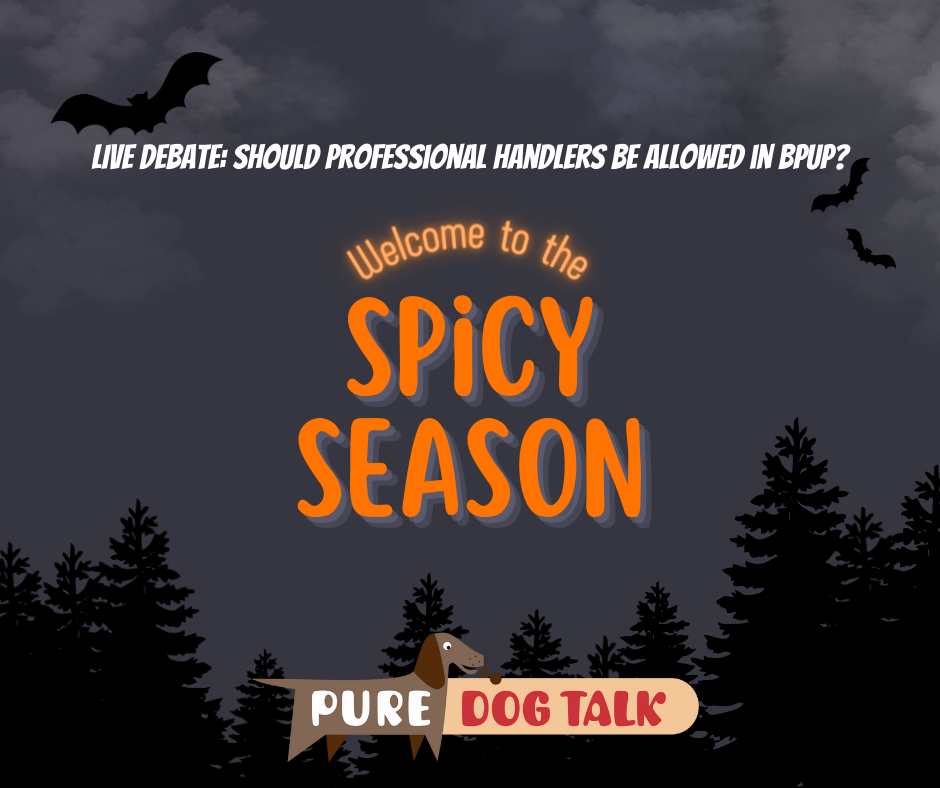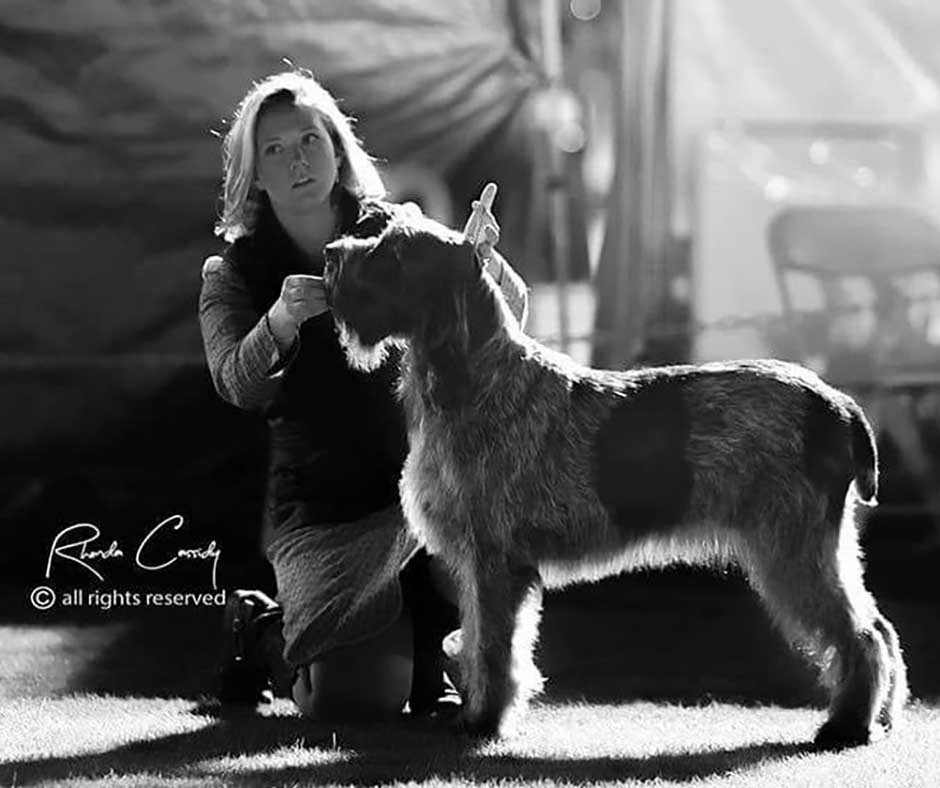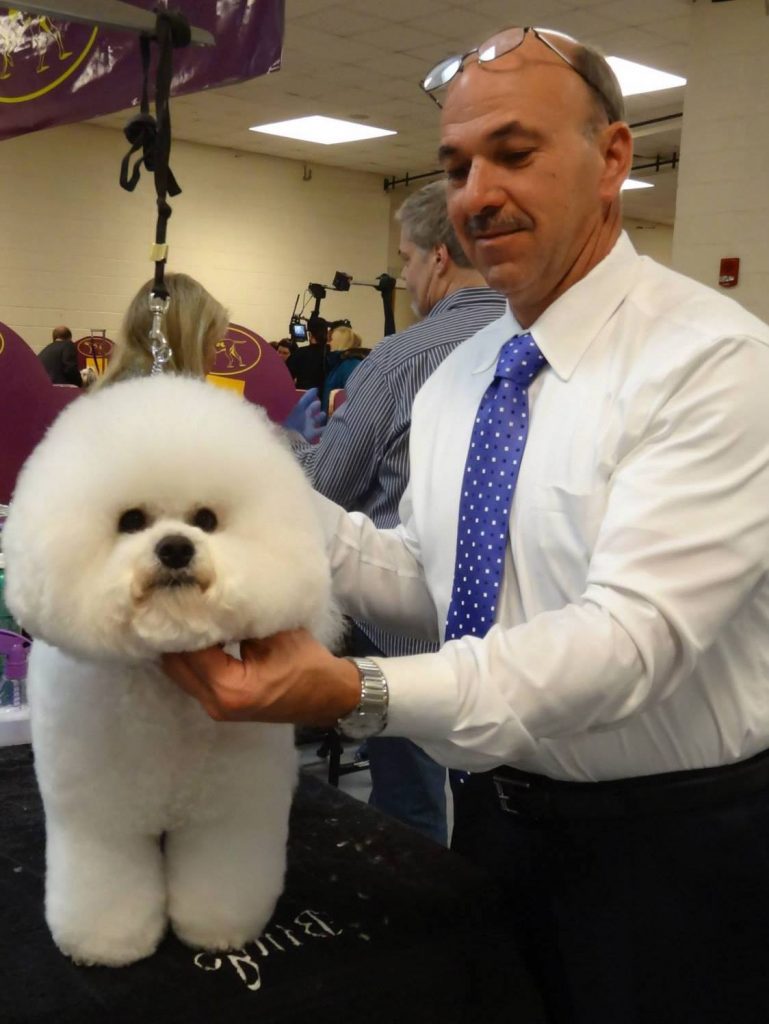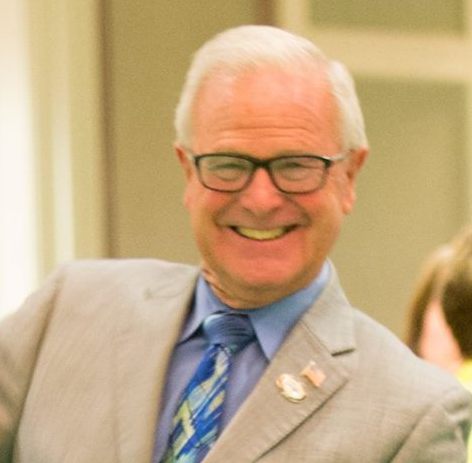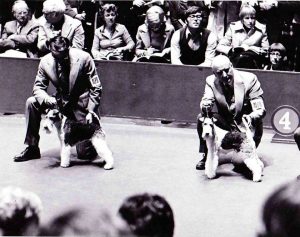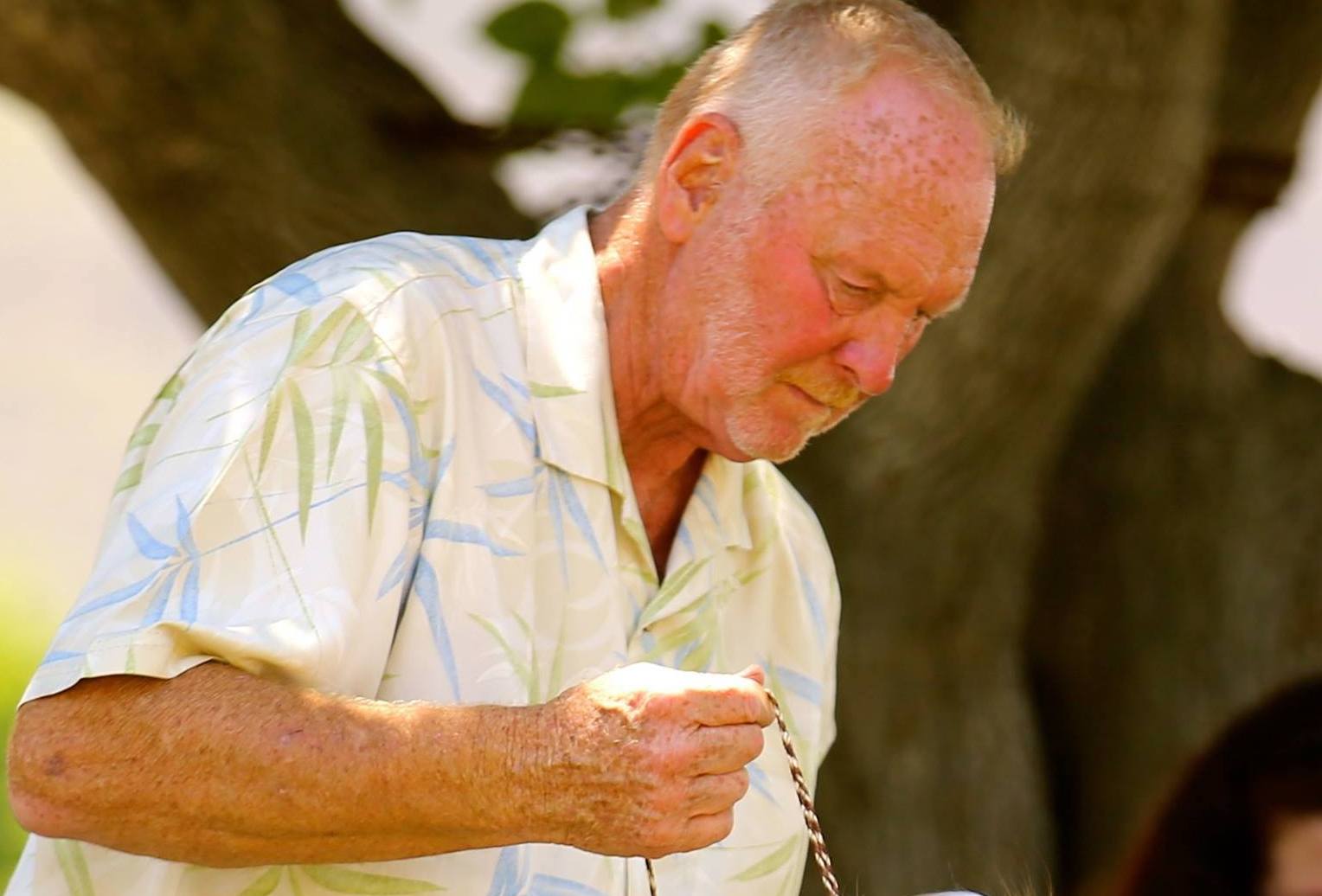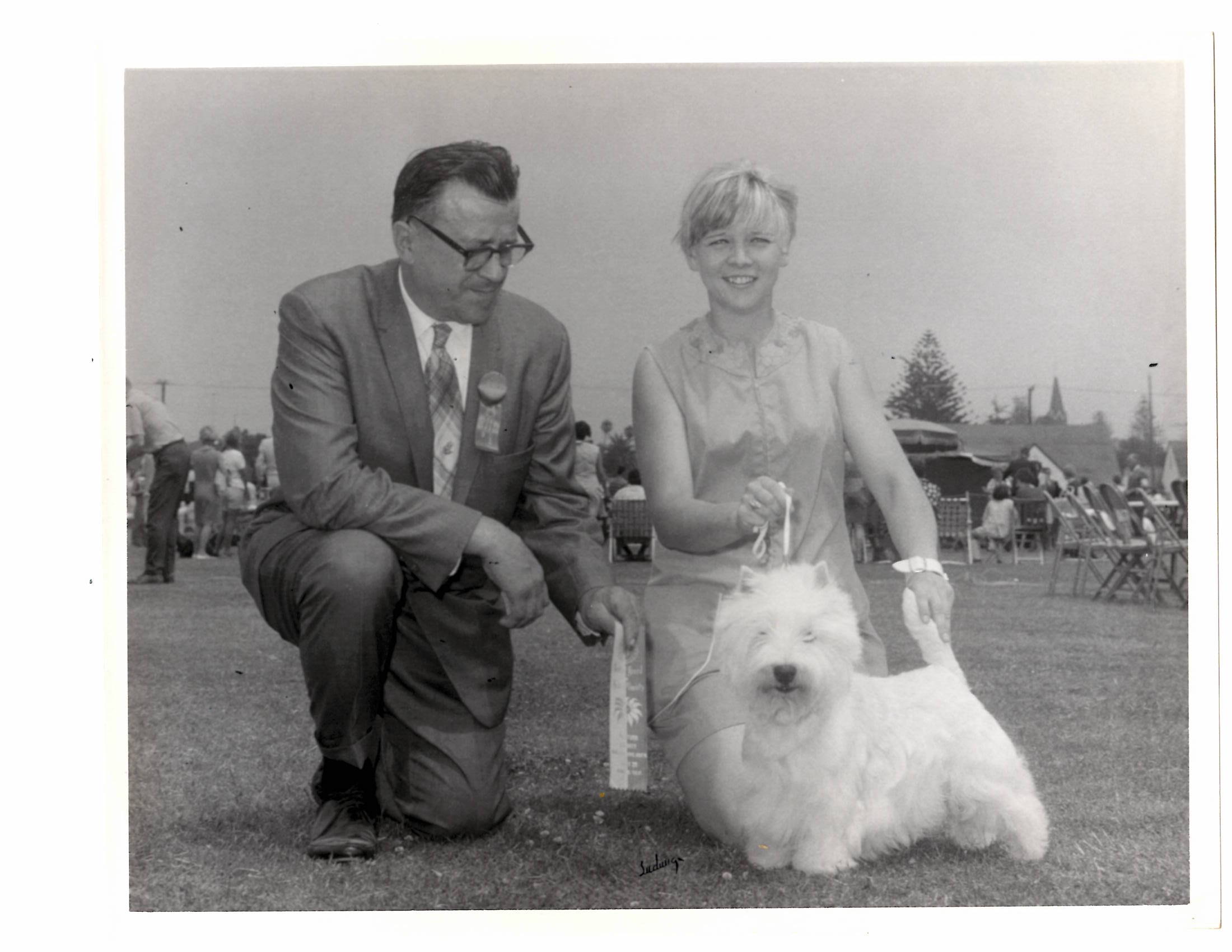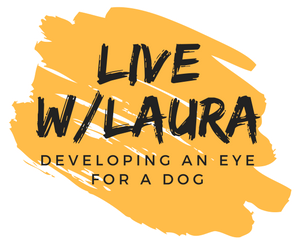605 – LIVE Debate: Should Professional Handlers Be Allowed in BPUP?
LIVE Debate: Should Professional Handlers Be Allowed in BPUP?
Our final installation for Spicy October is a LIVE@5 debate between an owner handler and a professional handler regarding the hot topic of the rules around the BPUP, 4-6 months puppy competition.
Natalie Thurman, owner handler:
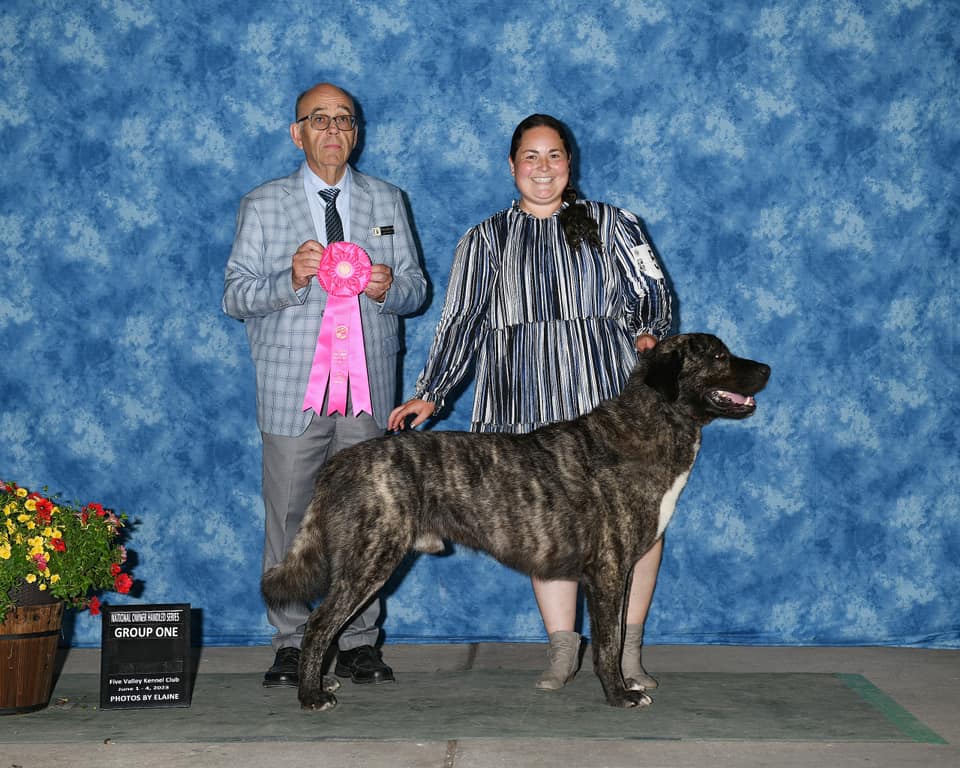
Natalie Thurman and Ares winning Owner Handled Group.
I do think that there are people who start out and it is intimidating to go up against the Laura’s and the Karyn’s of the world because you just make it look so easy and then we try to go do it and then it’s not as easy. Not even a little bit. I mean I know it’s why we have owner handled groups. But if you’re not getting to the owner handled group either BPUP could be a good place to feel safe as a non-experienced dog show human.
Karyn Cowdrey, professional handler:
I believe everyone should have the opportunity, including breeder owner handlers, to show in BPUP. Why? Because the fact of reality of our life today is there are fewer and fewer handling classes people can get to. As handlers, often we’re the ones teaching the handling class and we don’t get to work our dogs in the environment. As a handler, it is important to me that my puppies that I own, that I bred, that I decided to keep, get the best experience they can in the
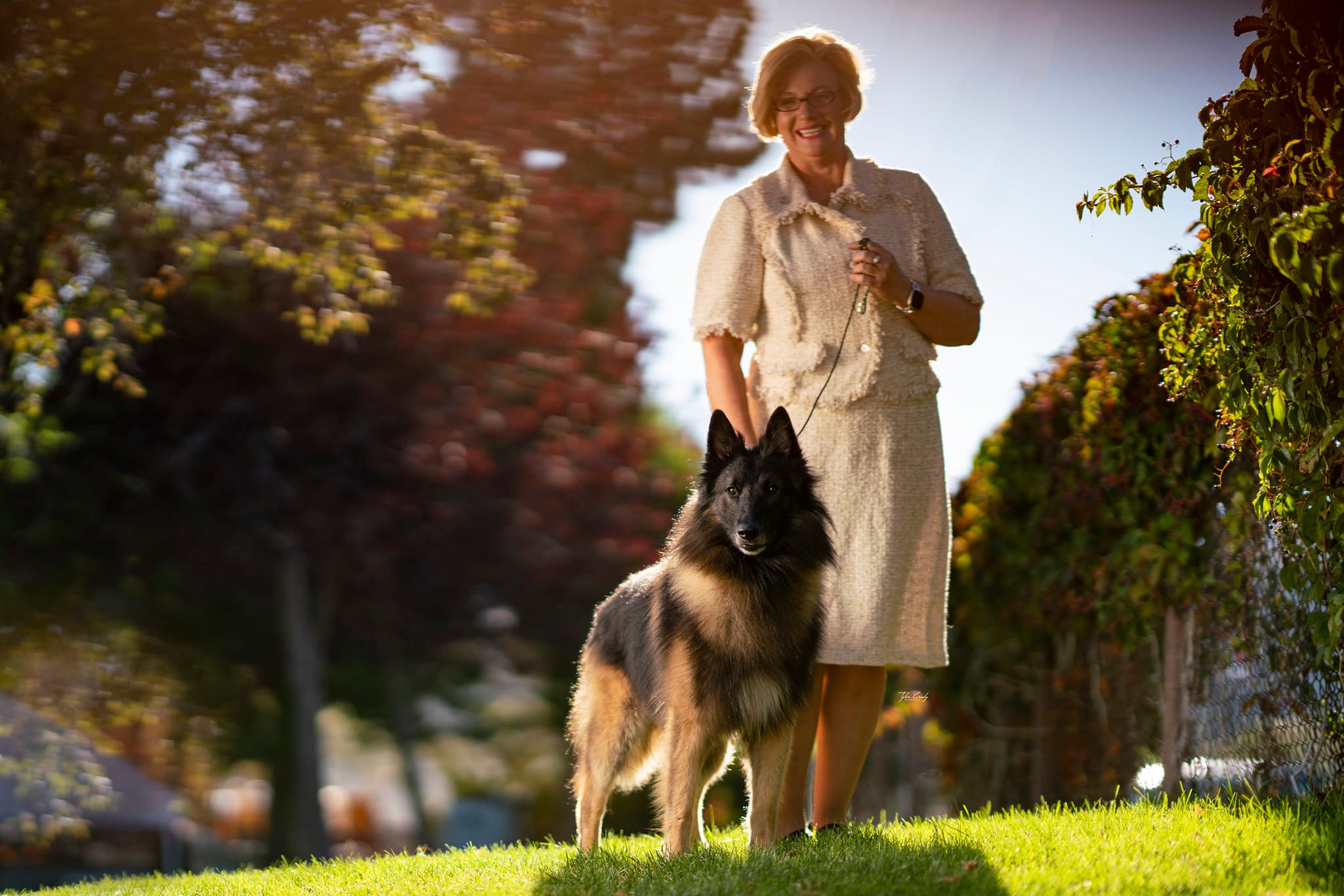
Karyn Cowdrey, BlackFyre Handling Services.
start of life in the ring. I shouldn’t have to hand them off to a total stranger.
Laura Reeves, host and moderator:
The concept (of BPUP) is that the American Kennel Club wants to support the novice handlers and that the simple presence of someone more capable than they are, whether they be a professional or a breeder or what have you, is unnerving. And I don’t know that that’s a great solution. I think we all learn by being challenged, but I know it is something that is a thing.
AKC gets banged a lot for not being encouraging and inviting and we as the representatives of the AKC get banged for the same thing. I sincerely believe that for people who think it is a big deal, they should get to do that. They should get to have that moment.
Hope is what gets us and keeps us. And I guess that’s what I would pin Best Puppy to. Is that baby inkling of hope. That tiny tingle of hope that the very new person gets when they get their first puppy.
And they are so excited and they don’t know what the hell they’re doing. And their breeder’s probably shoving them in the ring. And they’re really encouraging them to do this. It’s hope. And I guess to me, when I judge it, when I see it, best puppy to me represents hope. It represents the hope that we as breeders have for those puppies that are in the ring. It represents the hope that those owners and handlers have for their new puppies. It’s hope.
BPUP represents the hope that those owners and handlers have for their new puppies. It’s hope.
The part of me that thinks that hope is important, thinks that owner handled being what is important and encouraging new people being what’s important, I see the argument to make it a quote -unquote safe space from professionals.
Join us for the full replay of this spicy hot topic.
574 – Kelly Shupp on Campaigns, Rare Breeds and Generational Change
Kelly Shupp on Campaigns, Rare Breeds and Generational Change
Kelly Shupp, Professional Handler, joins host Laura Reeves for a deeply insightful conversation about running a show campaign, the challenges of competing with rare breeds and the generational change happening in her circle.

Kelly grew up with German Wirehaired Pointers bred under the Mountain View prefix.
Shupp grew up with purebred dogs owned by her mom, AKC judge Claire Wisch Abraham. Starting with Chesapeake Bay Retrievers and transitioning early to German Wirehaired Pointers, the mother-daughter team competed in shows, field events and obedience.
In 2012, Phil Booth showed their homebred GWP Oakley, GCH CH Mt. View’s Ripsnortersilvercharm, owned by Victor Malzoni, to #1 All Breeds.
Shupp was mentored by top professional handlers in the US and Brazil, including Booth, Damara Bolte, Angela Lloyd and Jane Myers, before launching her full-time handling career. In 2022, she showed the Spinone Italiano Josie, GCHG CH Collina D’Oro Solo Un Bacio, to a record- breaking career, capped with winning the Sporting Group at the AKC National Championship.

Kelly and Josie share a special bond.
“It is a special thing to run a rare breed,” Shupp said. “They’re not always in the placements. There’s judges that will point to rare breeds and judges that won’t. It’s a game. We learn certain chess pieces that fit and ones that don’t. With a rare breed they’re very specific (pieces) for sure.”
Generational change is taking over in the handling ranks, Shupp noted.
“This year we had so many young people in the group ranking competitions,” Shupp said. “Blake and Arial in the terrier group, me and Joanne in the sporting group.”
Planning a campaign includes evaluating a budget, competition and geographical location.
“The conversation I typically have with a client the start of the year is you go hard through March, see how it goes. Are you placing a lot in groups? Winning 75% of your breeds? You see if you can start placing more.
“You never go into a year saying I’m going to be #1 sporting dog. You see how it goes. Those are things you don’t really say. Those high-end top dog races just kind of happen.”
Flashback episode on planning a campaign.
More pro tips:
- Ask the right questions to find the right handler for you.
- Have those sounding boards to talk about judges and shows with experience-based knowledge.
- You can’t be better if the people around you don’t want to help you be better.
- Know your standard. Know about the breed you’re presenting. It’s such an important part of our job. To be an ambassador for the breed. To honor the breed.
- Flip flops are deadly….
- Everything happens for a reason.
- The greats never stop learning.
355 – Scott Sommer on Owner/Professional Handlers Relationship
Scott Sommer on the Owner/Professional Handlers Relationship
Scott Sommer, handler of two different Westminster Kennel Club Best in Show winners is back for the third and final installment of his conversation with host Laura Reeves.
Today we’re talking about owner handlers and professional handlers. Plus, Sommer talks about the most difficult trimming techniques he learned and offers invaluable tips from an experienced veteran about working with scissored coats and other tricks of the trade.
Handlers compete with the best to improve
Discussing the Owner Handled competition, Sommer reflects on the past when direct competition between amateur and professional handlers forced owners to “Step up and compete with handlers, which made them better.”
“Owner Handled allows them to compete against one another. I’m not opposed, but I think it separates the whole dog show world,” Sommer observed. “It takes away from people’s ability to learn. You have to compete with the better (competitor) to make your dog better. It makes a difference.
“The Owner Handlers have to compete with people who can make a dog look like it isn’t. It’s a hard thing to do. I worked for Michael Kemp for 16 years. Even now, I struggle with some things. It takes a long time to learn.”
Still learning after all this time
Sommer said that even after 40 years, his biggest struggle is trimming a dog’s off-side front leg.
“It’s horrible,” Sommer said. “The hardest thing in the world for me to get right was the neck in to shoulder. The best thing you can do is never touch the head and neck until a day after they are bathed. You can trim the body. But if you trim (the head/neck of a Bichon Frise) right after you dry, there’ll be no hair left. It needs at least a day.”
Sommer noted that climate, humidity, and even water quality makes a tremendous difference in coat texture. He advised bathing a Bichon two to three days ahead of the show in order to have enough spring in their coat.
“When I was in dry areas, I’d just spray water and pat the hair down,” Sommer said. “Kaz (Hosaka, legendary poodle handler and protégé of Anne Rogers Clark) taught me that.
“There’s so much to tell people. (Learning all of this) doesn’t just happen overnight.”
347 — Tracy Szaras: “Pretty Good, but it’s Not Perfect Yet”
Tracy Szaras: “It Looks Pretty Good, but it’s Not Perfect Yet”
Professional handler Tracy Szaras, whose Hungarian heritage leads her mother to describe her as a “real Gypsy,” says the pursuit of perfect is her secret to success.
Szaras showed her first dogs in grade school, because her mom showed dogs. Her mom was a great trainer, Szaras said, who helped her process questions. Mom taught her proper conditioning and basic animal husbandry.
Szaras’ first breed is Lakeland Terriers, so her mom took her to Montgomery County Kennel Club for the first time almost 30 years ago.
Montgomery County started it all
“I saw all these dogs looking awesome, everybody dressed to the nines. I really got into it that weekend. That next year I went to work for Greg Strong. I thought I knew how to pull hair until I went there. He showed me how to do flatwork, to do it correctly. I became driven. Greg taught me more, about trimming, skittish dogs, etc. I learned a lot in a short time.
“Then I went to Bergit Coady and learned about low-legged terriers. On my days off I went to Gabriel Rangel‘s kennel to learn more.
“I was a sponge. I didn’t even date. All I wanted to do was learn and know everything about terriers.
“I learned detail work from Gabriel. Learned by watching. I learned to trim, especially heads, from Gabriel.
“I thought I was going out on my own. Next came Maripi Wooldridge. When she was considering quitting, she wanted me to take over her clients.
“I was amazed. I thought I’d learned all I could. There’s always something to learn. Now, I’m always looking. It looks pretty good, but it’s not perfect yet. I want to be the best. I don’t want to shortcut anything, thanks to Maripi.
292 — Jeff Heim: “Dog Shows Are Not Dying” and Other Punditry
Jeff Heim: “Dog Shows Are Not Dying” and Other Punditry
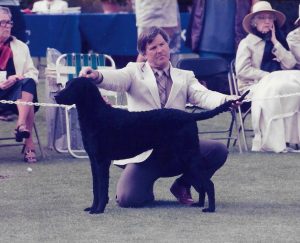
Professional handler Jeff Heim with a Curly Coated Retriever in 1985.
Professional handler, Jeff Heim, reflects on 50 years of learning, from cattle judging in FFA to observing handlers and judges at dog shows.
As someone who is always willing to help, talk to a stranger or answer a question, Heim observed there is a fine line in mentoring.
“You need to offer advice in a way people will hear it,” Heim said. He also encourages new exhibitors to watch other handlers to learn.
“Find the handlers who are above average,” Heim said. “Watch them. See what they are doing, take that move home and try it on your dog… not everything works for every dog. Learn what the handler is doing and why, with that particular dog – they’ve done the trial and error to get to that point.”
Heim repeats, for the umpteenth time in a row, the downfall of “drive through dog shows.”
“You cannot come to the dog show, show your dog and go home,” Heim said. “Spend some time. You spent your money. There’s a whole dog show here. Go watch breeds that are similar to yours. Then go watch breeds that aren’t similar. Watch the judges all day.”
“A judge can only judge what you present to them,” Heim noted. “The judges are not going to make up what they want to see, they are going to judge what you show them. The mediocre dog with a great handler is going to beat the great dog with an average handler most of the time. Because the great handler never lets the judge see the dog’s faults.”
Amongst his myth busting thoughts, Heim blows away the idea of “DNS Lists.”
“There is no judge I will not show a dog to. It’s a waste of time. You pay your money and take your chances. But know the type of dog the judge will like,” Heim added.
In his typical bluff fashion, Heim also opined that dog shows are not dying.
“The sport isn’t going to die,” Heim insisted. “This sport was going during wars. These days we have a lot of shows and entries are down because they’re all spread out. Dog shows are not put on for your entertainment. They are for earning championship points. The entertainment is on you. Put together a potluck with your friends. Sit down, talk, learn about each other. Dog people all have varied backgrounds. Put your phones DOWN! Interact with each other. If you aren’t having fun, maybe you need to change your group.”
218 – Legendary Dog Man Peter Green Brings History to Life
Peter Green riffs on great dogs, great rivalries and great memories
Join a wonderful conversation between legendary dog man Peter Green and his former apprentice Robert Paust, now an AKC judge in his own right. The two old friends reminisce about great dogs of the past, great wins, great friendships and great rivalries.
Green’s Welshman brogue has blurred but not faded from his voice in the 50-plus years he’s been working with dogs in the U.S. Starting in dogs showing Welsh Terriers with his uncle, Green began his career in the States in 1963. As was common at the time, he worked as a private handler for a prominent kennel to learn the business.
WKC BIS with the Lakeland
His professional handling career kicked in to high gear after he won Best in Show at Westminster Kennel Club with the great Lakeland Terrier, Ch. Stingray of Derryabah, in 1968. In a career that spanned 40 years as one of the pre-eminent professional handlers in the country, Green piloted dogs to the big ribbon at the Garden four times. He is slated to judge BIS on the green carpet this coming February.
Green was very definite on his favorite dog of all time. In all the dogs, in all the years, the Wire Fox Terrier, Ch. Sunnybrook Spot On was his choice without hesitation.
Spot On vs Dominator and other great battles
Peter Green, left, with Spot on and George Ward, right, with Dominator in one of the most-watched rivalries of the era.
Listening to Green flashback to the tremendous competition with his friend and rival George Ward, showing Spot On’s son, Ch Aryee’s Dominator, is a rush. Even as he’s reminiscing, Green is teaching without even thinking about it. He talks about how he showcased his dog’s movement in this high-stakes competition.
Dog show drama was alive and well, even in the “good old days,” according to Green. Good natured rivalries, and even those that weren’t so pleasant, behind the scenes stories, flaring tempers and redemption all flow from his memories.
Enjoy this priceless window into history.
188 – Bruce Schultz’s Secret – Be Happy for the Other Guy
Bruce Schultz’s Secret to Success and Longevity – Be Happy for the Other Guy
Bruce Schultz is a living legend in the world of professional handlers. Still actively showing dogs, Schultz said the secret to his longevity is being happy for the winner.
“You’ve gotta be happy for the other person,” Schultz said. “I think that’s why I’ve lasted so long. I know there’s good dogs out there besides my dogs. I’m happy for the people who win, like they should be happy for me.”
Dreams of a Young Man
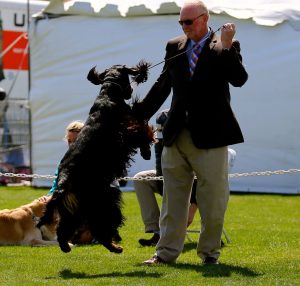
Professional handler Bruce Schultz with Gordon Setter. Photo credit Sharon Carvalho.
As a kid, Schultz loved hunting. His first really good hunting dog was a German Shorthaired Pointer he bought for $50 from the breeder after it was returned by the original owner. “He was so dedicated and so smart. I shot many a pheasant over that dog.”
But his dream was to own an Irish Setter. He bought his first from a breeder in Phoenix. “We found a litter in the newspaper,” Schultz said. In those days, advertising dogs in the local newspaper was standard practice. The breeder was an obedience competitor, so Schultz worked his new puppy in obedience, earning a CD on him at nine months old.
As he traveled to shows in Arizona and Southern California for obedience competition, Schultz watched the conformation classes also.
Conformation Looks Easy!
“My first impression of conformation was ‘These guys don’t have to do anything but run around the ring, pose their dogs and somebody points at them,’” Schultz said. “‘Obedience we have to work at it. We have a judge that scores you and if you make a mistake you’re outta there!’”
He eventually bought a couple Irish Setter bitches and began showing them in conformation. Over time, people started asking him to show their dogs. This was at the time handlers had to be licensed by the American Kennel Club in order to charge a handling fee. “I got really hooked on it, started showing more dogs and here I am.”
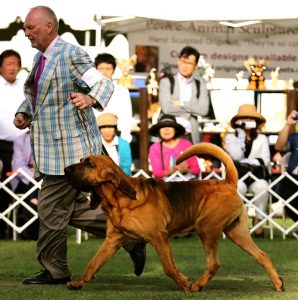
Bruce Schultz with Bloodhound owned by Susan Hamil. Photo credit Sharon Carvalho
Schultz became a licensed professional handler in the late ‘70s, right before AKC ended the practice.
Record Setting Career
“I’ve been very, very lucky with the dogs I’ve shown,” Schultz said. Amongst his records is piloting the top-winning GSP in the history of the breed. Brittania, BIS/BISS/NSC Can Ch DC NMK’s Brittania V. Sibelstein HOF won 50 BIS and 150 Group 1 awards in two years in the 1980s. His next top special, the English setter bitch, Ch Goodtime’s Silk Teddy, had the same record and won three national specialties, also in just over two years.
The ideal “specials” campaign, Schultz said, is usually 2 ½ years.
“It depends on the dog. There are dogs that love it. Every dog is totally different,” Schultz said. “You not only have to think of the owners, you want to do it, the dog wanting to do it. Those two dogs could have gone further but I figured ‘hey, I did enough with ‘em in the time period.’”
Running for number one, Schultz said, is time-consuming and mentally and physically draining. Keeping the dog mentally capable of doing it is the biggest challenge.
Friends AND Competitors
But the importance of maintaining friendships and friendly competition, even at the highest stakes level, is one of Schultz’ critical observations. He reminisces about his Border Collie going second in the group at Westminster Kennel Club behind his friend Jimmy Moses’ German Shepherd Dogs for years.
“Never beat him at the Garden,” Schultz laughed. “I beat him one time in the group. I still remember the show! It was Snake River, Idaho. But we’ve remained friends over the years. Business is business.”
Chris Terrell, breeder, owner, handler of the WKC BIS winning Afghan Hound Pepsi, Ch. Kabik’s The Challenger (https://www.nytimes.com/1983/02/16/sports/afghan-westminster-best-in-show.html), was another of Schultz’ friends. Terrell, an amateur owner handler, and Schultz frequently socialized after competing head to head in the best in show ring.
“Pepsi is one of my favorite dogs of all time,” Schultz said. “Chris and I traveled together. Whoever won, won.”
Schultz noted that he has concerns with a lot of the newer handlers because they “expect to win every show, no matter what they bring in the ring. They think everything has to be fixed for them. Why don’t you just show the dogs. We used to have fish fries, steak fries, people mingled.”
Learn From the Past
Looking to the past, Schultz observed, is imperative to learning for newer exhibitors.
“They have got to look into the past. Who did what, what were the great dogs,” Schultz noted. “They don’t study pedigrees, they just go out and breed. They don’t have clue of who the grandparents are. Grandparents are a huge influence on the get.
“…Good breeders of the past studied pedigrees. They knew the backgrounds of the dogs. They studied their breeds. The good dogs in different breeds, those breeders are still on top of their pedigrees.”
Listen to the podcast to hear Schultz’ Tips for Winning When the Chips are Down and his fascinating Dream Best in Show Lineup! This list of dogs from the ‘50s through present day is delicious. Sneak peak, can you name this dog?
Learn about one of Schultz’ long-time clients, Susan Hamil, and her Bloodhounds in PureDogTalk episode 64: https://puredogtalk.com/64-bloodhound-mantrailing-and-canine-health-foundation-tick-program-with-susan-hamil-2/
178 — Bergit Coady Kabel: “Groomed to Perfection”
A Legend in the Terrier Ring
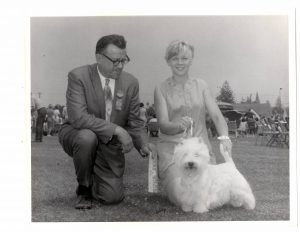
Bergit Coady Kabel with a West Highland White Terrier in years gone by.
The 2012 Winkie Award for Best Professional Handler, said it best: “A legend in the Terrier ring, Bergit Coady Kabel’s dogs are always groomed to perfection and flawlessly presented. Always polite and professional, she is totally dedicated to her dogs.”
Hard Work and Dedication
Bergit was someone I admired from afar for my entire handling career. I didn’t get to see her often, as our paths rarely crossed in the particular shows we attended. Every time I saw her, I was impressed by her immaculate charges and her unfailing smile.
I talk with a lot of folks for the podcast who have achieved the highest levels of success in purebred dogs. And I consistently hear the same themes. Hard work. Dedication. And an unquenchable thirst for knowledge. Bergit is a leading voice in the chorus.
Responsibility Gave Joy
Bergit tells the story in today’s podcast about being 13 years old and excited beyond words to have been taught by her earliest mentor how “to clean teeth, bathe dogs, express anal glands, and clean ears. … and the happiest kid you could have found.”
Let that sink in for a minute. Here is a kid who was *thrilled* to do anal glands because “Finally I knew a few things to do with dogs.”
Many successful handlers apprenticed for Bergit over the years. “A few assistants that wanted to do this by the clock, needless to say, did not work out,” she noted.
After a recent illness, Bergit is recovered and ready to take on judging with that same focus and intensity.
Focusing on Judging
“After 50 successful years of handling, I feel I can try to give back a little to a sport that has given me so much,” Bergit said. “I know judging will present different challenges and I will educate myself every step of the way. Will I like it better than handling? Never. I loved every minute of my handling career.
“…my son Ryan said to me. He is fully aware of my love for handling. He said, ‘You know, you are very lucky that you can go into judging. There’s a whole big world and big dog family. So you can see your friends again.’ He does mortgages and he said, ‘When I’m done there is no mortgage family waiting for me.’”
Bergit’s concrete advice on reaching the pinnacle of perfection in trimming dogs is invaluable. And we start a new feature on the show “All Time Favorites Best in Show Lineup.” Listen now to hear which dogs she would have in that ring and who would win!
Laura: Welcome to pure dog talk, I’m your host, Laura Reeves, and I am joined by a member of our sport who I have long had mad respect for and I think she just brings such incredible knowledge to the game of purebred dogs. So I would like to welcome Bergit Coady Kabel to our conversation because I think you guys are going to really, really enjoy this one. So thank you. Bergit. How are you today?
Bergit: Really good, thank you. Very good. Excellent.
Laura: So we have a thing here on pure dog talk that we ask our guests to give us the 411, right? The who, what, when, where, why, how, how did you get started? How did you get involved in dogs? You’ve been at this for a lifetime now, right?
Bergit: Yes, definitely. Yes. I will have to tell you how it all started. When I was five years old, my family moved from southern Germany to downtown Hamburg. Soon after that, my earliest recollection is this, and a bit old neighbor girl was able to walk a wire Fox terrier for friends. One day she let me hold the leash. I was so thrilled and could not wait to tell my mom. You would have thought I won a box of toys. I have always been crazy about dogs. Maybe got the gene from my grandmother. She loved animals. A few blocks away from where we lived in Hamburg was a grooming shop owned and operated by Mr and Mrs Buchhaltz, who were excellent dog people and also show people. They owned a Mini and a Toy Poodle, an Irish Terrier and a Scottish Terrier. For a long time I was forever trying to figure out how I could get to know them. Remember I was only a young kid then, and the dog world was not like it is today. My break came when the Buchhaltz’s daughter, who was in the same class as my younger brother, came into the classroom and asked for her parents. They were looking for a babysitter for the two year old sister. Bingo. I was it.
Bergit: I babysat… and every minute, after my job was done, I was spending time with the dogs. I was a dog walker at first and I kept telling the Buchhaltz to please teach me grooming. I was fascinated by what all the employees could create. So after awhile Mr Buchhaltz decided he had to do something with me since I was always around. The first things he taught me was — this is no kidding — to clean teeth. bathe dogs, express anal glands and clean ears.
Laura: And you were how old Bergit?
Bergit: I was 13 at the time. And the happiest kid you could have found. Finally I knew a few things to do with dogs. At that point they also started to take me to some dog shows, you know, later on in life, much later on in life. I kept thinking back to this and I was thinking maybe Mr Buchhaltz thought, you know, if I let her do all of these things…we’ll get rid of her! But it didn’t happen. By the time I left school, I agreed to a three year apprenticeship with the Buchhaltz. My parents were devastated. My mother’s dream was for me to be a super secretary like she was, but sitting still has never been easy for me. So at this point, the Buchhaltz did not really need a fourth girl.. the three they had were excellent. So they asked if I would like to go to England to work in a well known Scottish Terrier Kennel “Riander” for Mrs Elizabeth Meyer. They took me with them to Crufts and we were introduced and I looked at all the Scotties like many people would do and said, how do you know which one is which one? So this was the basic beginning to my fabulous life into dogs. I spent two years in the UK and then one year at the Buchhaltz grooming shop. They agreed to the second year if I agreed to no time or days off for that. year. That was fine. I didn’t care.
Bergit: So basically my most important mentors besides the Buchhaltz was Mrs Meyer of Riander fame. To this day, I refer to something I was taught by her daily and we don’t even own our kennel anymore. There are two most important elements that I live by. Mrs Meyer said, number one, you have to be able to take care of yourself first before you can take care of someone else or something else. Second, when taking care of dogs, you yourself have to know what goes into a dog and what comes out of a dog, so you have to look at each one every day. From her I learned how to put down a Scottish terrier, and once a month she insisted to drive me to a well known Westie breeder who taught me how to trim Westies I would spend all day at her place. Now comes the question of how did you come to the United States? Well, spending two years at the Riander Kennel in England, I met many American Scottish Terrier breeders that came to visit the Kennel. One day, Betty Malinka of Sandoone Scottish Terriers, visited and asked if I would like to come for one year to work for her in Gary, Indiana. I agreed. End of history. This year, March 12, was my 50th anniversary of arriving at Chicago O’hare.
Laura: That is pretty amazing. Bergit. I’m sorry. That kind of made me a little choked up for a minute.
Bergit: Yeah. Yeah. That’s amazing. Working for Betty was fun. She took me to a lot of shows and also I met a lot of people and that’s how I met Clay Cody.
Laura: Yes.
Bergit: We started with our limited experience but taught ourselves a lot by watching top handlers at the time. Yes, we were fortunate to have some great dog people apprentice under us… and we are still very proud of them. Again, trimming you can teach, conditioning as well, but you have to have a certain feeling for dogs. If you had assistants that wanted to do this by the clock, needless to say, that did not work out.
Laura: No,
Bergit: We always started from scratch. If a dog needed a new coat, it was stripped down… in 10 to 12 weeks later you started to show it. It takes that long on any strip breed to get the coat into show length.
Laura: Yeah.
Bergit: In the meantime, you will take care of furnishings and everything else on the dog, exercise and fresh air are of great importance… and having had a super kennel with 58 runs in southern California for 40 years was more than ideal. We also had a set of runs where you could get a profile view of the dog from the dog kitchen, and that was enlightening and very useful. All of the above we brought to the attention of all of our assistants. Your question about habits to condition and groom a dog, is difficult to answer. A dog has to feel you like him. That’s the start of everything. Then you start by putting him on the table every day, often just for a little while because once a dog is stripped, you have four to six weeks before you do what we call a defuzz, which is the same as a cleanup, but furnishings need to be washed every two to three days and blow dried.
Bergit: The dog gets used to your hands and where you put them. Be consistent in making the same movements. Always be peaceful. Don’t do any of this if you need to rush. By the time you need to put a final show trim on the dog, he should be able to stand on the table perfectly relaxed and display confidence. Anyone with love for dogs can do this — Owner-Handlers or Handlers. The secret ingredient, as you call it, to a perfectly trimmed dog, is looking at it as many times as it takes on the ground, after you finished trimming it in front of a mirror, of course on the table. Then on the ground, someone has to walk the dog for you so that you can see him in profile as well as up and down. Whatever you need to correct… then you correct it, but you can never take a dog off the table even though it looks perfect and think that that’s how it’s going to look. Because once the dog shakes or moves differently, you can have a completely different picture.
Bergit: So this is of course more work and a lot of people’s excuse is they don’t have somebody that can walk the dog, BUT you can always, if you get to the dog show early, find somebody that would do it for you, and even if they don’t walk it correctly or perfectly like you would, you can still see certain things. The other thing that a lot of people don’t do is to take a dog for a regular walk. I don’t mean at a dog show. I mean just down the street to look and hear and see strange things. Always talk to your dog and pet him in between. You will bond nicely. You have to have good work ethics, a lot of self discipline and most of all a passion for this whole dog show scene in order to make it work.
Laura: I would agree with that.
Bergit: After all. Then you asked me about judging.
Laura: YES. This is a new journey that you’re taking on, right? Just getting started, yes?
Bergit: Right, after 50 successful years of handling, I feel I can try to give back a little to a sport that has given me so much. I know judging will present different challenges and I will educate myself every step of the way. Will I like it better than handling? Never. I loved every minute of my handling career. To end this interview, I would love to tell you what my son Ryan said to me. He is fully aware of my love for handling. He said, you know, you are very lucky that you can go into judging. There is a whole big world and big dog family. Most of all, you know each other. So you can see your friends again. He does mortgages and he said when I’m done, there is no mortgage family waiting for me.
Laura: I love that. It’s totally the truth, Bergit.
Bergit: It’s totally the truth.
Laura: You know, I just got done interviewing Lorraine Boutwell for example, and she talks a lot about this and a lot of the people I talk to about this, they started in dogs either as breeders or as breeders and then handlers or what have you… and continued judging and I think so much of it is because this is your family. Right?
Bergit: Right. Right. And I mean, you have no idea. I mean when I got sick, I mean I still have all the cards and all the stuff and I mean it was incredible. You know, I was just truly overjoyed and now everybody that sees me at a dog you know, goes crazy and is happy for me
Laura: like I did.
Bergit: You know, I’ve always tried to help everybody. Because people tend to dislike you when you win a lot, but you know, that’s never affected me. You know, I’ve always given credit to where credit is due and you know, I think people remember that. You know.
Bergit: I think so too. So two more things. Your best advice… especially for the people that are getting started. We have lots of people who listen to this podcast who are less than five years, for example, with purebred dogs. What is your best advice for these folks when they’re getting started? Showing their dog, grooming their dog, whatever it is.
Bergit: Definitely to get the best rapport going with your dog. That means you take the dog for a walk just as a pet. You pet it, you talk to it. You make sure it learns to stand on the table perfectly still so that you can groom it. Whatever dog it is… in order to groom it you can’t be fighting with it. That you can’t be every time making excuses, for it or all these things. But if a dog knows that you want this from him, you give him so much. To my mind, the dog can also give something back to you and they’ll figure it out. I mean it doesn’t matter what we dealt with many different bleed, you know, so you have to be patient and then when you need help you try and get helpful my hand low or if you watch somebody at a dog show that you think could give you ideas, you approach that person at the end of the day or when there’s a break, obviously not while they’re showing a dog, you know, most people will help you and that’s how you really keep going. And if you run into somebody that won’t help you, don’t be discouraged and go to the next person that you think could do it for you.
Laura: Yeah, and I think that that’s so true. And one of the things that has kept me going, I mean every time I handle a new breed… I go ask someone. That’s just a thing I do and I think that if you just are willing to ask, people are always willing to help, somebody will help you.
Bergit: Yeah. I mean look at it. A few years ago somebody offered us a Komondor. I had finished two Wheatens for them in 1987. They said to me, do you want to show a Komondor? And I said yes. I said, I don’t know much about them, most people don’t, but I said Bill McFadden knows and I’ve seen him show one. And I said I will talk to him and I will get all the information and I will do everything he tells me. So I got it finished. And of course you have to be friends with people in this breed because there’s so few of them that you have to know when there will be a major, you know. And we got it done. But it was really interesting, you know, I mean it was great to do it differently like that.
Laura: I did a Briard, I mean completely outside my comfort zone. And it was great fun, I really enjoyed it because you get that chance, right, to learn something new.
Bergit: Yeah. Yeah. And the same with the Black Russian. I got a Black Russian finished… also with the help. This is when the kind of first started, you know, also with the help of key people and you know, I’ve never forgotten the people that have helped me, you know, and they get a Christmas card every year. I mean I’m a great Christmas card writer. I’m sorry. I like to do that. You have to do these things, you know.
Laura: Yes, absolutely. Okay, so then listeners, you guys are gonna love this. We’re going to add this as a new feature for all of the interviews that we do with some of our great legends of the sport and Bergit gets to be our test case. So Bergit? Now you have 50 years in the sport in the United States. So I’m asking you in your mind, and this is a game we play as handlers, right? Like, I’ve always done this. So, in your mind, the greatest best in show lineup of all time… of dogs that you have personally seen. Ready, Go!
Bergit: I would say for the Hound Group – Pepsi, the Afghan Hound. For the herding group… Manhattan, the German shepherd. Non-Sporting would definitely be London, Standard Poodle, black Standard Poodle. Terrier… Coco the Norfolk.
Laura: Wow. That says a lot coming from you. Wow!
Bergit: Yup. Yup. Working… and that would probably win my best in show right there, Matisse, the Portuguese water dog.
Laura: Okay…Wow.
Bergit: Toy…John Oultan’s Papillon, Kirby,
Laura: Beautiful.
Bergit: Sporting… the Black Cocker of Michael Pitts — Beckham.
Laura: Those are some beautiful, beautiful choices and I think since I saw this in somebody else’s social media and I said, it tells so much about what you value as a judge, as a handler or what have you, what you see in that best in show lineup. I just think it is a wonderful, wonderful thing. Plus it makes us think about cool little dogs. Awesome. Alright, well Bergit, thank you so much for your time. It was wonderful to see you at the dog show a few weeks ago. I am thrilled to see you back and I wish you the very, very best in your judging career. You will be outstanding.
Bergit: Thank you so much. I appreciate that. Thank you. Take care. Okay..bye-bye.
177 — Developing An Eye For a Dog: Recorded LIVE
Developing An Eye For a Dog: Recorded LIVE
San Mateo Kennel Club invited PureDogTalk to sponsor a live expert roundtable at its all-breed show in March. Exhibitors who participated were treated to a rare opportunity to interact directly with some of the most knowledgeable people in the sport. Judges Pat Trotter, Desmond Murphy, and Ken Murray were joined by professional handler Andy Linton to address the topic of developing an eye for a dog and answer audience questions.
“Lifers” Share Their Knowledge
These folks are what we think of as “lifers” in dogs. They started young with a passion for dogs and have applied that intensity to achieving their goals as breeders, handlers, and judges. Each and every one of the panelists is a lifelong student, who possesses the noted “eye for a dog” we were discussing.
While each of the panelists brought their own perspective to the conversation, there was complete agreement that developing an eye for a dog entails focusing on and rewarding a dog’s virtues rather than picking at faults. Riffing on a quote from the well-known judge of the ‘60s, Bea Godsol, whom Trotter noted was gifted with a tremendous eye for a dog, the panelists each shared their spin.
Ken Murray – “Great dogs carry their faults well,”
Pat Trotter – “An absence of faults doesn’t guarantee virtue,”
Desi Murphy – “Great dogs blind you to their faults.”
Andy Linton agreed, noting also that, “having an eye for a dog gives you responsibility in so many ways. Do I take that dog to show? Do I put that dog up? Do I breed that dog? The more you know, the more responsible you become.”
“An eye for a dog,” according to Trotter, “is when you see one that gets your attention. It’s an arresting animal because it exudes beauty and correctness. Like a work of art.”
Trotter added wryly, “Sometimes great dogs get lost at shows where they are the right look. They’re different from the other dogs who are, shall we say, modest at best.”
Even if a person isn’t “born with it” in terms of that eye for a dog, Trotter does believe that studying and learning, and listening to the greats in a breed will allow someone to develop the skill.
Murphy qualifies that with an observation that some people are simply better at the skill than others.
“I mean there were certain subjects, if I went to school for 10 years on that subject I would never have been any good,” Murphy observed. “… judges are like dogs. You have excellent, very good, good, satisfactory and unsatisfactory.”
When an audience member asked how to know which judges have an “eye for a dog” and how to discern to whom they should show their “great dog that doesn’t look like the others,” Bill McFadden, speaking up from the gallery, noted we all need “an eye for a judge.”
Trotter summed up much of the advice with this observation, “I think one thing that helps breeders is to look at your own dogs with a jaded eye. Look at them with a jaded eye and see their shortcomings. And look at your competition through rose-colored glasses. That will help you advance in your efforts to become a better evaluator as a breeder and exhibitor.”
Please enjoy this special and valuable conversation. What it may lack in our normal audio quality, it more than makes up for in the quality of the knowledge.
Additional Q&A coverage from this event is available ONLY to our PureDogTalk Patrons! Click the button on our website to “Be My Patron on Podbean” for more information about joining the “in” crowd.
And, making a surprise Thursday appearance, Allison Foley’s Tip of the Week from the Leading Edge Dog Show Academy provides insight on dealing with stains on white dogs.

